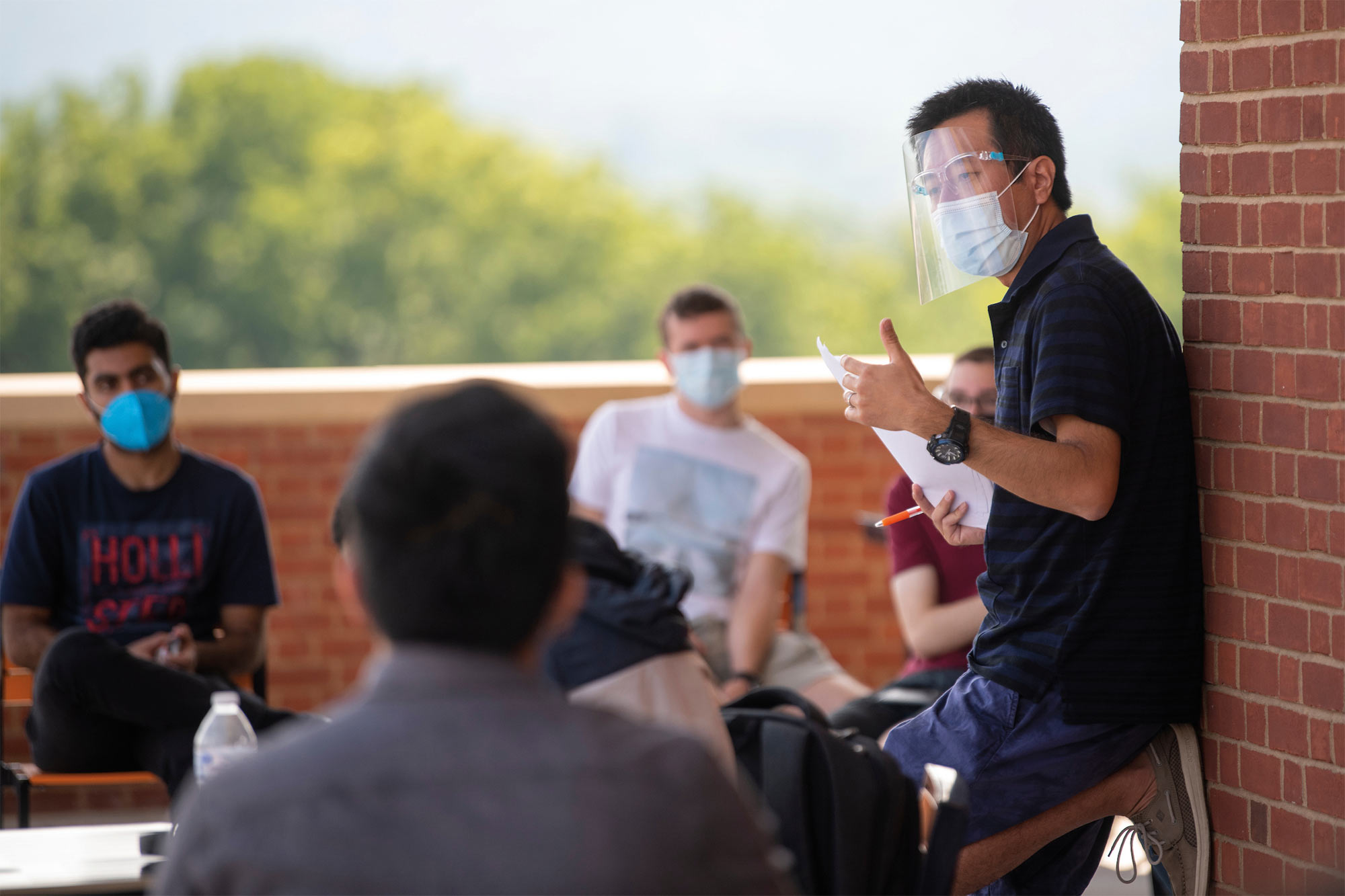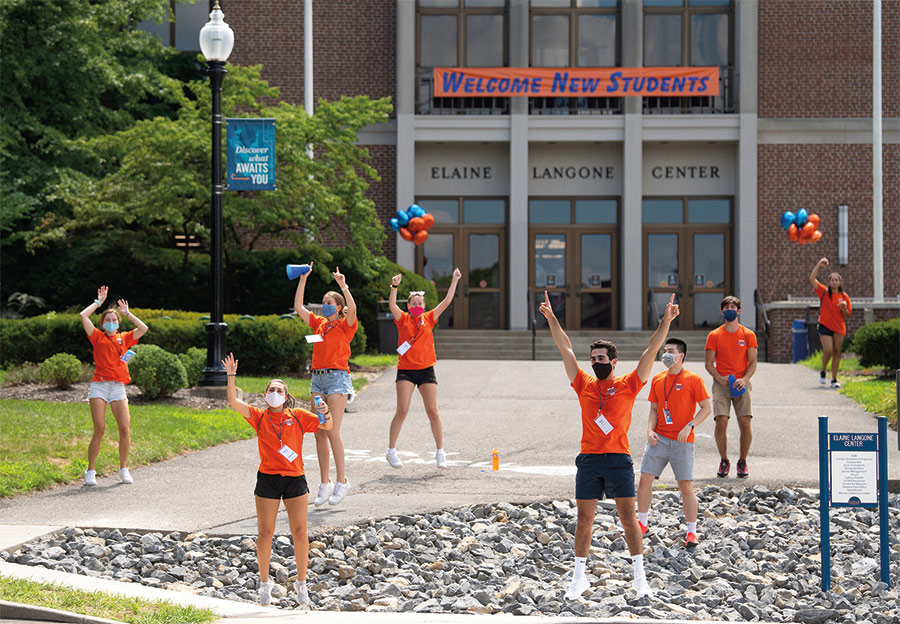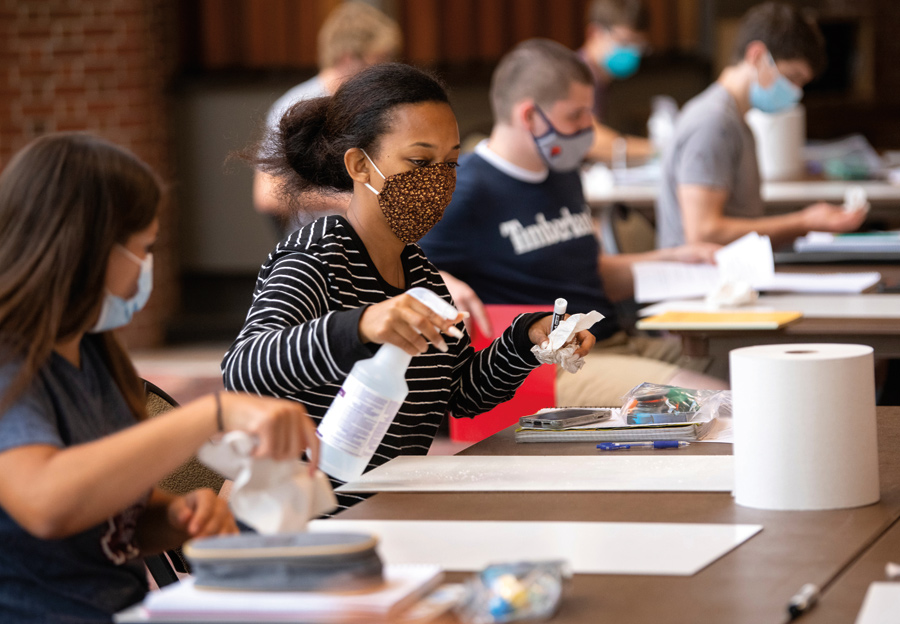

eturning to Bucknell’s campus felt like stepping onto a movie set to Jaden Lee ’22. At the semester’s start, the mechanical engineering major was still getting used to taking visual cues from the more than 10,000 signs hung on campus over the summer, illustrating where to stand while waiting for food, checking equipment out from the library or directing one-way movement through buildings. “It’s like stage directions: ‘Go upstairs one way and down another.’ ‘Stand on this spot,’ ” he says.
The proliferation of signs as well as face coverings — many in orange and blue — might have been the most obvious indicators of change as Bucknell reopened on Aug. 17 for an in-person fall semester amid an ongoing pandemic.



Bottom: On the first day of classes, students get into the groove of an unusual academic year.
Faculty led the same engaging labs and engrossing discussions but in modified and often larger spaces, including outdoors, or in venues such as the Weis Center for the Performing Arts. Cleaning and disinfecting of classroom spaces ramped up, as it did in residence halls. Dining shifted toward to-go service and outdoor seating, eliminated buffets and made-to-order options, and offered identical meals at each venue at meal times to mitigate crowding.
Move-in, usually a flurry of cars, carts and excited students packed into a frantic morning, was spread across more than a week to allow for physical distancing. It also occurred earlier than usual, part of an altered schedule that moved up the semester’s end and eliminated fall break.
Those new protocols were put to the test before the semester even began, as Emily Baird ’24 experienced.
The Dallas native was quarantined in her room shortly after she arrived, when a student on her hall tested positive. Baird left quarantine two days later when it was determined that she had no close contact with the student. While she took the early close call in stride, she does worry that she might have to “start from square one again coming back from Christmas break,” she says.
Those same concerns weighed heavily for Bucknell President John Bravman, but the incident also offered evidence, he noted in an email to faculty and staff, “that our process is working.”
Among the in-person offerings were chemical engineering courses led by Professor Kat Wakabayashi, who was eager to resume the personal interaction he considers a teaching strength. “It is just much easier to achieve that in person, even with half of our faces covered and standing six feet apart,” he says.
Returning to campus required Wakabayashi to juggle lab schedules, prerecord lectures and livestream labs for remote students with a camera on his forehead. But as he stepped onto the outdoor balcony that would serve as his fair-weather classroom and saw his students, Wakabayshi says he knew he “made the right personal choice.”
In the waning weeks of summer, many schools that announced plans to return to campus rescinded or made modifications to those plans, such as allowing only first-year students to live on campus. As Bucknell classes began, some universities, including UNC-Chapel Hill and Notre Dame, halted in-person instruction amid COVID-19 flare-ups. At press time, Bucknell had avoided such measures, but the need for vigilance was as strong as ever.
Near the end of the first week of classes, Bravman wrote to remind the student body that “no place is safe from COVID-19” and said he would take action if conditions emerged that would threaten the health of the campus or Lewisburg.
“I truly do not want to do that, but I will if the facts demand such action,” Bravman wrote.
To Lee, who returned to campus early as an Arts First Pre-Orientation adviser, the thoroughness of Bucknell’s approach was apparent.
“The University has very strategically done this,” he says. He hoped it would be enough to sustain the in-person experiences he looked forward to for his junior year.